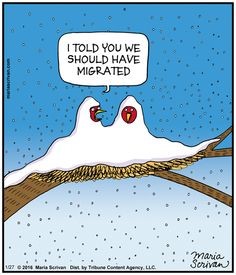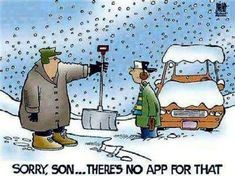Address any questions or comments regarding this newsletter to the individual authors listed after each article or to its editors, Nathan Johanning, 618-939-3434, njohann@illinois.edu or Bronwyn Aly 618-695-6060, baly@illinois.edu. The Illinois Fruit and Vegetable News is available on the web at: http://ipm.illinois.edu/ifvn/. To receive or be removed from email notification of new postings of this newsletter, contact Nathan Johanning or Bronwyn Aly at the phone numbers or email addresses above.
In This Issue:
Upcoming programs (listings for beginning and established growers)
News & Announcements (M-CERF Illinois Producer Survey, Midwest Farmers ‘Good Food’ Survey, Pest Degree Day Calculator Gets Upgrade, 2021 Midwest Fruit Pest Management Guide Grower Survey, Farm Commons: Farmers Guide to In-Kind Wages)
Regional Reports (Cook County, northern Illinois, west central Illinois (Macomb), southwestern Illinois (Waterloo), southern Illinois (Murphysboro), Dixon Springs)
Fruit & Vegetable Production & Pest Management (Weather & Climate Summary, Demonstration of Production Methods for Ginger (Zingiber officinale) in Illinois)
Upcoming programs
See the University of Illinois Extension Local Food Systems and Small Farms Team’s website at:
http://web.extension.illinois.edu/smallfarm/ and the calendar of events at http://web.extension.illinois.edu/units/calendar.cfm?UnitID=629.
- 2021 Small Farms Winter Webinar Series, Thursdays starting at noon, from January 21 - March 25, 2021. Plan to spend your lunch hours learning more about local food and small farm related topics this coming year. If you still need to register, follow this link Winter Webinar Registration .
- Purdue Extension Vegetable Farming Webinar Series, Every Wednesday in February, starting February 3, 2021, 2 PM to 4 PM EST. For more information or to register visit https://www.indianahortconference.org/.
- 2021 25th Annual Stateline Fruit and Vegetable Growers Conference. This year, our conference will be delivered via the Zoom platform. Because of the breadth of content, our conference will be held over multiple dates. These webinars will be held live. The core of the program, fruit and vegetable disease and insect updates from Drs. Mohammad Babadoost and Kacie Athey, Extension Specialists with University of Illinois Extension, will occur on the following dates:
- Thursday, February 18 (Fruit Track) 1:00-3:30PM
- Thursday, February 25 (Vegetable Track) 1:00-3:30PM
To compliment these tracks, we have scheduled additional sessions on Fridays in February. These Zoom sessions will be held from 12-1PM.
- Friday, February 12 - Hard Cider Production, Carla Snyder, Penn State Extension
- Friday, February 19 - High Tunnel Production Updates, Bronwyn Aly, University of Illinois Extension
- Friday, February 26 - Pumpkin Varieties, Nathan Johanning, University of Illinois Extension
To register visit https://extension.illinois.edu/jsw or contact Grant McCarty at 815-235-4125; gmccarty@illinois.edu
- Asparagus Production, Management, and Marketing (online meeting) Wednesday, March 17, 2021 from 10 A.M.. to 12 Noon (EST), sponsored by Penn State Extension. The presentation will be given by Carl Cantaluppi, Retired Area Extension Agent, North Carolina Cooperative Extension. The Meeting will be on. It will be free and open to all that are interested. Click on the link below to register for the meeting: https://extension.psu.edu/asparagus-production-management-and-marketing
News & Announcements
M-CERF Illinois Producer Survey
University of Illinois Extension Cook County is collaborating with researchers from Illinois Institute of Technology and DePaul University, who are mapping the contributions of local farmers and food producers within a 300 mile radius of Chicagoland. Other partners include Chicago Food Policy Action Council and the Illinois Stewardship Alliance.
The survey is designed to understand what types of “good food” practices local farmers are already doing and the benefits and challenges of implementing such practices. “Good food” practices relate to safety, nutrition, environment, labor, animal welfare and local economy, and are increasingly in demand by institutional and retail customers.
Individual response will be CONFIDENTIAL and only the aggregated results will be shared with participants and stakeholders. Farmers will be able to see how they compare to their peers across the region. Other stakeholders will use the results to inform outreach and training to enable more local farmers to participate in “good food” purchasing contracts with Chicago and Cook County institutions, as well as sell to food hubs and aggregators interested in such practices.
As a token of appreciation for farmers time and willingness to share information, a $20 gift card will be offered to the first 200 farmers who complete the survey. If you are a farmer (urban or rural) within a 300 mile radius of Chicago please click this link to participate.
Kathryn Pereira (773-233-2900; kpereira@illinois.edu)
Midwest Farmers ‘Good Food’ Survey

We are reaching out to you as a key member of the Illinois farming community and an important contributor to our regional food systems.
The Covid-19 pandemic has shown how critical local farming is to the resilience of our regional food systems. We are a team of researchers from the Illinois Institute of Technology, DePaul University, and Chicago Food Policy Action Council who are mapping the contributions of local farmers and food producers to the Chicagoland food system. Through our work, we hope to identify new market opportunities and sales channels for locally produced food from businesses like yours.
We would greatly appreciate it if you could take 10 minutes to complete a survey to understand what “Good Food” practices farmers, like you, are employing and the challenges you face.
As a token of appreciation for your time, we are offering a $20 gift card to the first 200 people who complete the survey.
Your individual response will be CONFIDENTIAL and only the aggregated analysis will be shared with participants and other stakeholders. Farmers will be able to see how they compare to their peers across the region. Other stakeholders will use these results to inform outreach, training and other activities to enable more local farmers to participate in “good food” purchasing contracts. More details can be found in the survey itself. For further information or questions contact Dr. Weslynne Ashton (washton@iit.edu or 312-906-6517)
Kathryn Pereira (773-233-2900; kpereira@illinois.edu)
Pest Degree Day Calculator Gets Upgrade
The Illinois Pest Degree Day Calculator has been updated, featuring seven-day weather forecasts, graphs, and maps to help growers track accumulated degree days and light for several specialty crop pests. Coming changes were highlighted at the Illinois Specialty Crops Conference and also at the recent Southern Illinois Fruit and Vegetable Conference. The new website was released February 5. As we enter the growing season in a few short months, we hope you find the added value these changes may bring.
Previous degree day tools used the ICN data to provide current degree day accumulations, and projected degree days were based on historical weather averages. The ICN data remain vital for providing pest degree day information on the calculator.
The local seven-day forecast, based on weather forecasts from the National Weather Service, allows growers to know what to expect and to zero in on the potential progression of insect life stages while also determining when crops will be the most vulnerable.
In striving to develop new tools to aid in the timing of improved pest management, there are now three state maps, one each for the corn flea beetle and the prediction of potential Stewart’s Wilt severity, Japanese beetle emergence, and brown marmorated stinkbug activity.
The new tools were funded by the Illinois Department of Agriculture Specialty Crop grant program and the Illinois State Water Survey, a part of PRI. The tools are available here: https://go.illinois.edu/degreedays. The calculators are free, but registration to the WARM website is required.
Kelly Estes, State Survey Coordinator, Illinois Cooperative Agricultural Pest Survey (217-333-1005; kcook8@illinois.edu)
2021 Midwest Fruit Pest Management Guide Grower Survey
On behalf of the group that reviews and publishes the Midwest Fruit Pest Management Guide, we have included this survey link that seeks to gather fruit grower input on ways to make the guide easier to use https://iastate.qualtrics.com/jfe/form/SV_74GdBdHusZtMlAp . Please take the time to complete this survey and if you don’t have access to the internet and want to provide your feedback, feel free to call one of our UI Extension Specialists (contact list at the end of this newsletter). They can record and submit your feedback. Any questions can be directed to Lina Rodriguez-Salamanca at Iowa State University lina@iastate.edu or 515-294-0581. Thank you for your participation.
Kacie Athey (217-244-9916; kathey@illinois.edu)
Farm Commons: Farmers Guide to In-Kind Wages
I wanted to be sure you knew about a new resource now available from Farm Commons: Farmers' Guide to In-Kind Wages. Download it for free at this link until March 1. https://farmcommons.org/resources/farmers-guide-kind-wages
Small, diversified farms may not always have abundant cash available to pay workers, but boy, do they have broccoli! This guide will provide readers with a comprehensive understanding of the rules and regulations that apply when paying farm workers "in kind" wages. In-kind wages includes paying farm employees with meals, farm products like meat and vegetables, lodging/housing and other non-cash items of value. From understanding when in-kind wages are allowed, to how to value them, to the tax implications of paying in broccoli, we explore it all. The Appendices provide detailed information about specific issues including the OSHA, migrant/seasonal worker law implications, and tax rulings. The Appendices also provide selected state-specific information. (77 pages)
Farm Commons is a 501(c)(3) nonprofit organization dedicated to empowering the agricultural community to reduce legal risk and leverage legal opportunity within an ecosystem of support. Through education, leadership development and community-based problem solving around business law, agricultural communities become stronger and more resilient. The result is a legacy of sustainable farms and a community-based food system for everyone. At Farm Commons, paperwork is powerful.
Regional Reports
From the Cook County & South Suburban Cook Urban Agriculture Demonstration and Research site (SoSuCo) (Matteson, IL)… Hopefully, we have seen the last throws of winter here in Cook County. Winter was not leaving without a fight! We received another 6-8 inches overnight on top of the 14 inches that were already on the ground from the first snow event in February. Here is a picture of our high tunnel from the first snow event, as I have not yet had the chance to make it to the site after this most recent storm:
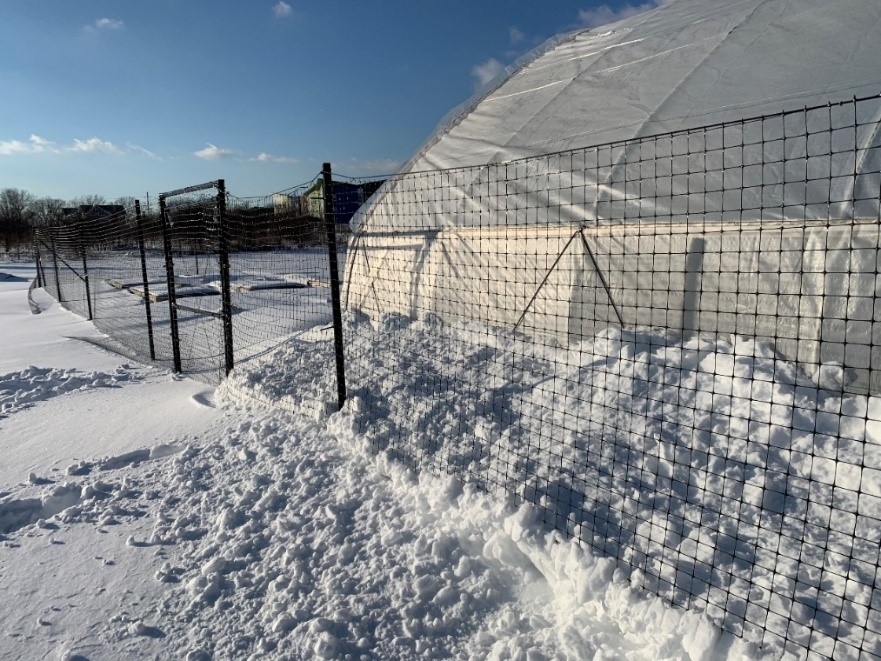
I discuss high tunnel shape and relation to snowfall shedding in my most recent Urban Ag Connect vlog. As you can see, large snow events can accumulate hefty snow loads that exert pressure on high tunnels, especially unheated ones. Our bows' gothic/gable style shape allows for a proper snow shed and accumulation on the sides of the tunnel. Quonset or semi-circle-shaped bows run the risk of peak accumulation and improper shedding, and in some cases, with heavy snowfall, structure failure without adequate removal. Although we don't currently need roll-up side ventilation, you can see that rolling up the sides would be a significant challenge with this much accumulation. This inability to roll up the sides in the winter is why having end wall ventilation, whether active or passive, is essential even during the winter months. Below you can see our three vent louvers on the west end wall. These open at different temperature stages with thermostatic control. We also have an active vent fan in the east end wall. Not all high tunnels can have active ventilation; however, end wall louvers can be installed with wax-triggered vent arms to open the vents without electricity.
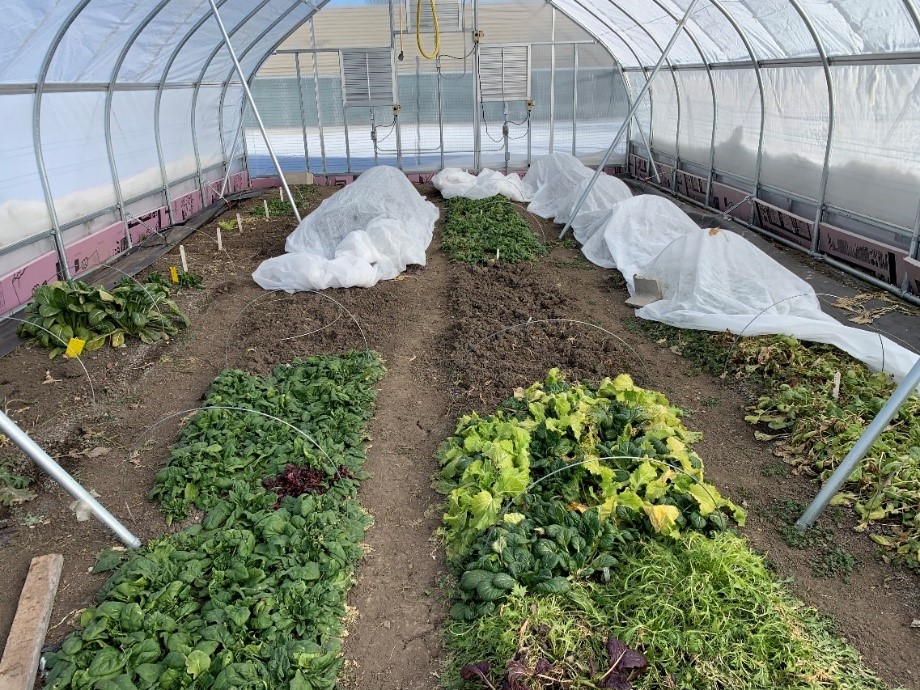
Not much to report on the production side of things. The above photo from 2/5/21 is the last picture I took inside the tunnel before this extended cold snap set in. When I return to the site, I expect to see data logger temperature readings approaching 0 F, as night time outside ambient air temps have reached near -8 F. I deliberately left some beds without a secondary layer of protection to see how far I can push cold hardiness, especially for the overwintered spinach plantings. Either way, the beginning of February marks the beginning of a new season in the unheated high tunnel. Most of the overwintered plantings will be removed and replaced with late winter plantings of cold-hardy crops. Direct seeding of carrots on 1/29 will be followed by transplanted kale in the 4th week of February and more direct seedings of baby salad crops.
Zachary Grant (708-449-4320; zgrant2@illinois.edu)
From northern Illinois (Rockford)… We are in the middle of our Stateline Fruit and Vegetable Growers Conference. Each year, this program provides updates from University of Illinois Extension Specialists while highlighting topics that growers request. We kicked off our virtual conference on Friday, February 12th with an overview on hard cider production from Carla Snyder of Penn State. Growers heard about the opportunities that exist and decisions that they need to make in order to get started. Our program will continue for the next two weeks on Thursdays and Fridays.
Snow and cold weather has been the common theme the last three weeks up here in Northern Illinois. Temperatures have stayed in the low teens and near 0 and below most days. Snow totals range between 8-10 inches in some parts of our counties with these snow measurements expected to linger for a couple more weeks. Tied with the low temperatures, it has meant a delay in pruning in some of our orchards with this task moving back into the end of February. Weather looks good for the next two weeks to accomplish it but certainly growers I’ve talked with were hoping to have this done the first part of February.
Grant McCarty (815-235-4125; gmccarty@illinois.edu)
From west central Illinois (Macomb)…Despite being under 20 degrees Fahrenheit for two weeks straight (and most days not even breaking into the twenties) growers are still preparing for the season. Flats of onions and high tunnel crops have been seeded indoors. While unrelated to vegetable crops, many landscape bedding plants are under plastic and the heaters are running non-stop. Any heater failure for these crops would result in disaster for the grower.
Before the cold, snowy weather, which seemed to arrive February 1, Central Illinois has been mild this winter. I suppose we are making up for that this month. We went into winter feeling the effects of a dry fall and looked to winter for some cold rainy days or a decent amount of snowfall. As of mid-February, the soils in McDonough County appear to be recharged. According to the state’s drought monitor, west-central Illinois is back to normal soil moisture levels. The central and eastern parts of the state still show “Abnormally Dry” to “Moderate Drought”. As one farmer mentioned to me in January it takes a lot to deplete our soils of water, but fortunately, a steady day of rain can often make up for that loss. We owe much of it to our healthy soils rich in organic matter.
Once again for 2021, there are supply issues. Fortunately, most growers have seeds and supplies in hand already. When speaking with a horticulturist in Cook County she remarked shortages are more due to staffing limitations caused by the pandemic than the actual quantity of supply. However, in 2020 many homeowners took up gardening for the first time and that trend appears to be continuing for 2021. CSA memberships were incredibly popular last year and again we’re seeing CSAs already selling out of memberships. Growers are stretching themselves to accommodate the increased demand locally. All of this also plays into higher demand for supplies.
Last year consumers saw bare grocery shelves or an inability to even access a grocery store. That was a wake-up call that left many fearful of food shortages. Local growers answered that call and showed our fellow citizens that there is a network of local food producers that are an amazing community resource. Hopefully, beyond the pandemic local fruit and vegetable farms will continue to be seen as critical infrastructure for communities big and small. Continued investment in our local food system will help you continue the noble act of farming and feeding us for generations to come.
Chris Enroth (309-837-3939; cenroth@illinois.edu)
From the St. Louis Metro east… The region is coming through the coldest and heaviest snowfall so far this winter. Temperatures took a dive below normal starting around the 6th of February and have stayed well below freezing since, including several overnight lows hovering just above or below zero. Using February 17 as a reference date, the current average soil temperature four inches under bare ground was 32.1°F compared to 37.3°F last year on the same date and 31.8°F on the same date in 2019. There is currently 6” of snow on the ground, and not the sticking kind, rather the type that easily drifts. Some growers with high tunnels have had a rough few weeks keeping the snow load off the tops and sides of houses, as well of protecting transplants from low lethal temperatures.
The 2021 Southern Illinois Fruit and Vegetable Conference was held virtually on February 10, in lieu of the traditional face-to-face meetings held in Hardin and Mt Vernon. For those who were unable to attend or would like to watch certain presentations again, all are available at https://www.youtube.com/playlist?list=PLA_ZYIJ7DS9ErZrcTrv0DaMfTeTPwIylv. Most of the presentations also have a handout available for download at go.illinois.edu/specialtycrops. If you attended, but haven’t filled out the program evaluation, it is available at https://illinoisaces.co1.qualtrics.com/jfe/form/SV_bshKSkA8zacyhPU. For those attendees who have already complete the program evaluation, thank you!
If you need a bound copy of the Midwest Vegetable Production Guide for Commercial Growers 2021 or the 2021-22 Midwest Fruit Pest Management Guide, both may be ordered online through Elizabeth Wahle’s office at https://go.illinois.edu/Order2021SprayGuide. We are shipping as orders come in. Both guides are available online as well. The Midwest Vegetable Production Guide for Commercial Growers 2021 is available online at https://mwveguide.org/guide (pdf) or https://mwveguide.org/ (online tool). The 2021-22 Midwest Fruit Pest Management Guide is available online at https://ag.purdue.edu/hla/Hort/Documents/ID-465.pdf.
Elizabeth Wahle (618-344-4230; wahle@illinois.edu)
From southwestern Illinois (Waterloo)… Last month I commented about the mild winter and lack of subfreezing day thus far, but saying “we are far from out of the woods so time will tell.” Well, time told alright, we are now approaching 2 weeks of subfreezing temperatures the last day we broke the freezing mark was 2/5. That first week we caught a few small snows and among all of them maybe had 2-3 inches of precipitations. There was just a little bit of sleet/ice in the midst of that, but it was minimal. Then the weekend of the 13/14 the bottom really fell out of the temperature with high by Sunday and Monday only in the single digits. Monday the “real snow” came it snowed all day, heavy at times we got an additional 8” or more of snow that day. It was light and fluffy and drifted a lot so exact totals were hard to determine. Since we have had another inch or so across a few days and a couple of small snow events. The coldest temperature I had was a morning low on 2/16 of -4°. From the forecast we are supposed to break freezing on Saturday with a high in the mid 30s and then by the middle of next week we will be up in the 50s for highs! I will say it has been a few years since we have had an extended cold period and having close to two weeks solid with snow cover. I do enjoy the snow, but do not look forward to the muddy mess that will ensue when we are in the 50s.
Not a lot, of course, to reports from the field. Prior to the larger amounts of snow, the ground was frozen consistently, and this was nice for field access for pruning or other farm maintenance. The snow was very beneficial for cover crops, strawberries and for sheltering the bases of brambles helping to protect all from the cold temperatures and winds. Having this cold of temperatures without any snow cover can lead to a lot more injury. Fortunately, air temperatures did not stay below 0 for an extended time so I am hopefully that being fully dormant, most of our tree fruit were able to weather the temperatures without substantial loss of flower buds.
Hopefully all are staying warm and safe this month!
Nathan Johanning (618-939-3434; njohann@illinois.edu)
From southern Illinois (Murphysboro)… Hello from snowy Southern Illinois! Since Monday we have accumulated around 9” of snow in Jackson County. The snow was pretty light and dry, and combined with the wind we saw some fairly large drifts accumulate. The temperatures have also been extreamly cold, with night temperatures being near zero. Today we have temperatures in the low 20’s and next week we can see temperatures in the mid 50’s here in Murphysboro.
Inside the tunnel I have seeded lettuce, kale, spinach, and various herbs. They are currently on the heating mat with domes. I hope to transplant them later this month, and begin working the raised beds in the high tunnel.
I hope everyone is staying safe and warm during this winter weather!
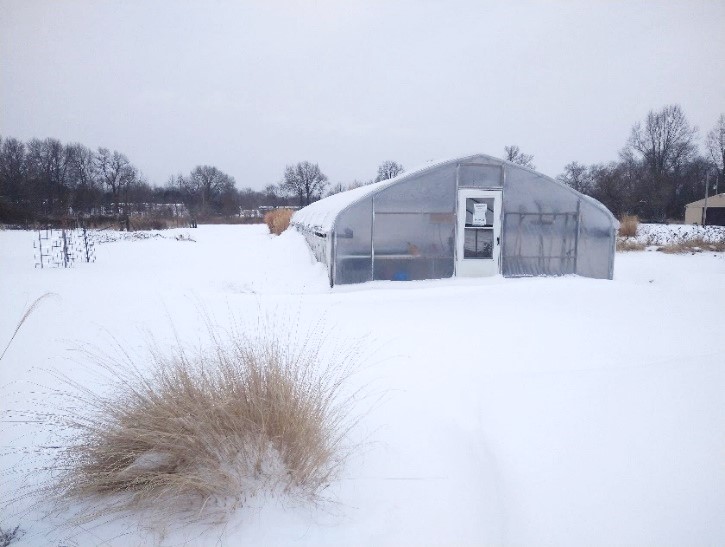
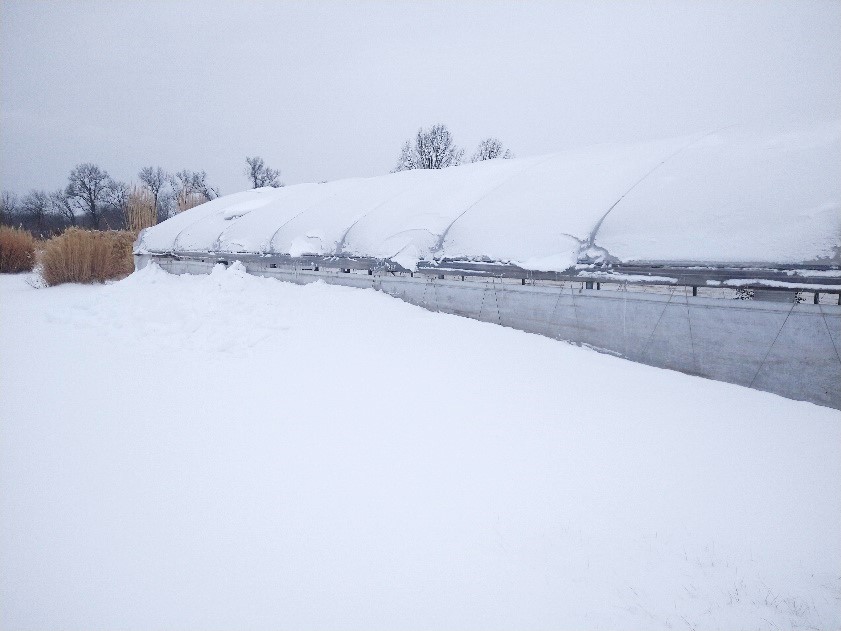
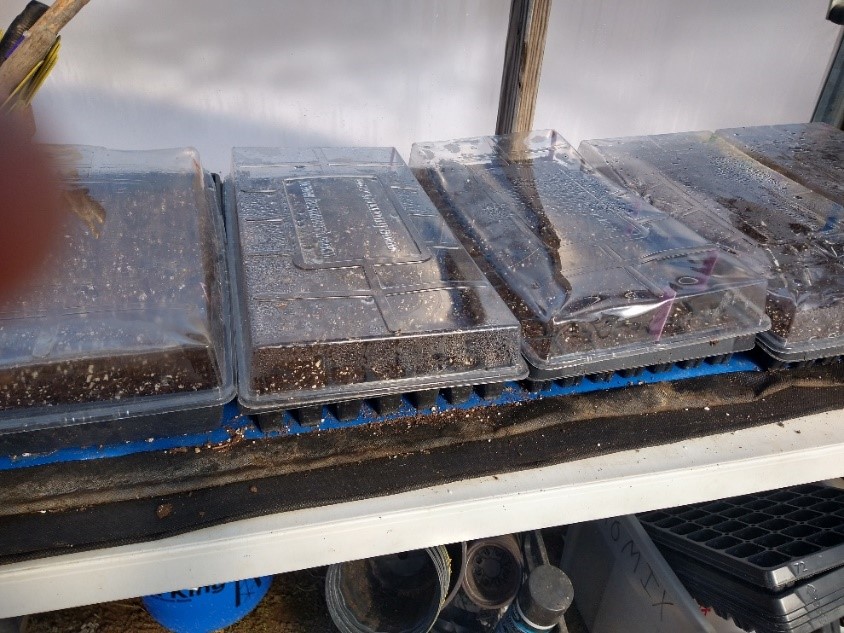
Katie Bell, Extension Intern, Dixon Springs & SIU Agribusiness Economics Graduate Student (klbell@illinois.edu)
From Dixon Springs Ag Center… Just like the much of the rest of the state, we have experienced temperatures below freezing for the past two weeks but that trend will break by the weekend. In the past 10 days, we received about 1/2 – 3/4 of an inch of ice that was then followed by about 9-10 inches of light, powdery snow. The wind that was blowing was a double-edged sword that kept the snow from accumulating on the high tunnels but also brought wind chills to below zero for a few days and nights. All of the tunnels made it through this winter event just fine. The only tunnel on which we did any ice removal was the one with no trussing. Several of the bows in this particular tunnel are a bit warped and the plastic does not stretch as tightly as we would like and sagging between these bows can cause a thicker buildup of water, ice and snow which could lead to a tunnel collapse if not addressed. The one issue this weather event caused was a frozen and then busted water line at an outside hydrant in front of the tunnels.
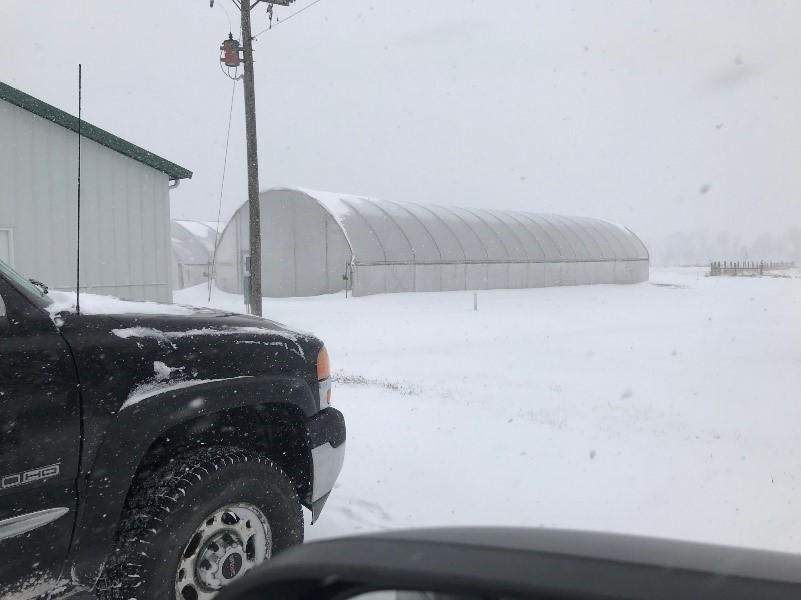
Snow drifting and blowing off of high tunnel at DSAC. The little bit of accumulation melted and slid off as soon as the sun came out. Temperatures inside the high tunnels on the sunny day were around 50-55 degrees F while the outside temperature was around 15 degrees F. Photos by B. Aly.
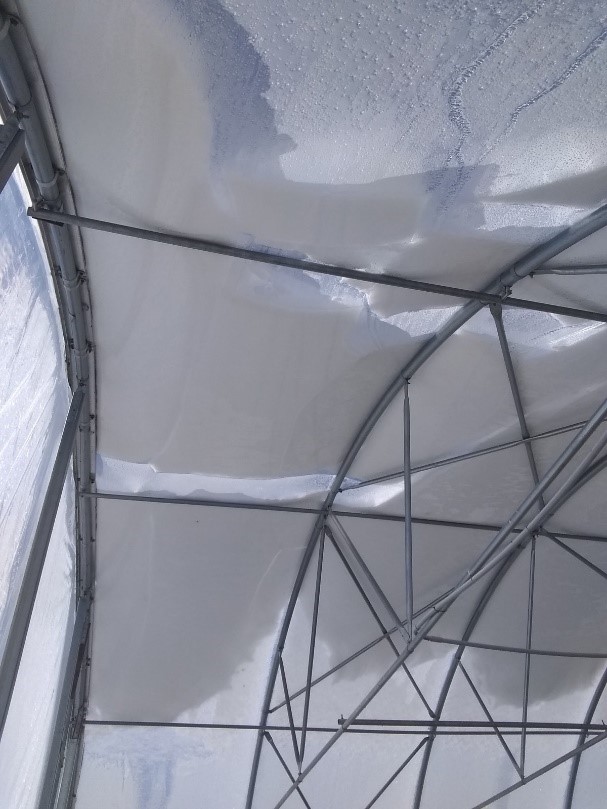
The winter vegetable plots with the row cover treatments were covered up almost two weeks ago as forecasted temperatures were going to be 25 degrees F or below and have remained covered. Thermometer readings within the tunnel show the lowest temperature near ground level was 10 degrees F. Observations of the plants within all of the plots in the research trial (both covered and uncovered) show no difference in appearance. It was noted that drip irrigation lines under the black plastic were NOT frozen while the lines laying on top of the bare ground were a bit frozen. The header and drip lines quickly thawed once the sun was shining.
All of the tomato and pepper seeds have germinated using heat mats in our greenhouse. Looks like next week we will be able to start potting up the seedlings, which I always look forward too. I love the smell of the potting soil and the feel of the warm humid greenhouse air.
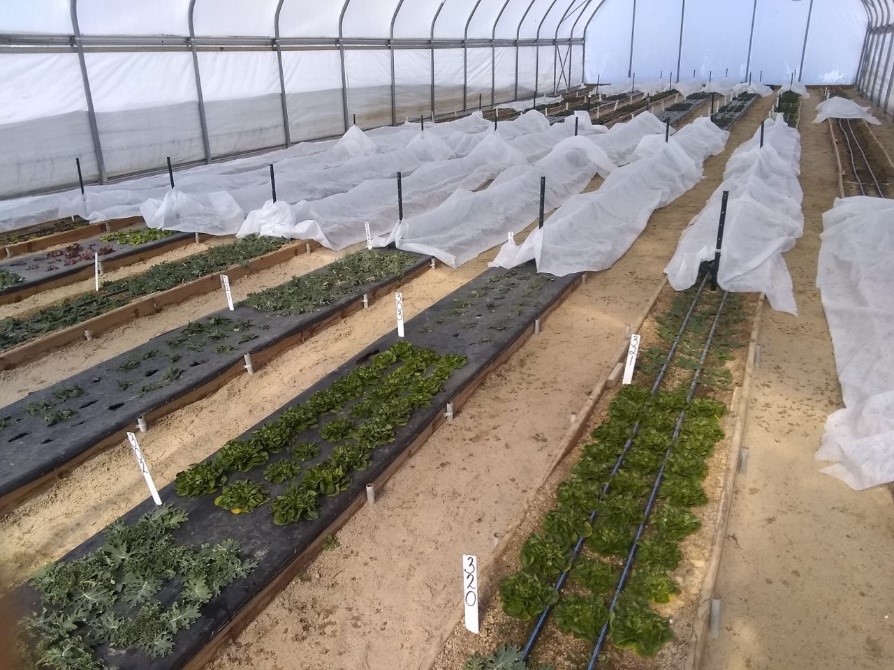
Winter vegetable research plots in high tunnel at DSAC made it through the two weeks of below freezing temperatures and almost 10 inches of snow. The drift on the west side of the tunnel is about 3 feet high. Photo by B. Aly
Bronwyn Aly (618-382-2662; baly@illinois.edu)
Fruit & Vegetable Production & Pest Management
Weather & Climate Summary
The statewide average January temperature was 29.5 degrees, 4.2 degrees above the long-term average and 30th warmest on record. However, a change in the subpolar jet stream brought much colder weather into the central U.S., which has persisted through the first half of February. Average temperatures between February 1st and 16th were 10 to 18 degrees below normal across the state.
January ended wetter than average statewide, with a statewide total of 2.32 inches. This was 0.19 inches above the long-term average and 42nd wettest January on record. The change in the jet stream to start February also brought a more active storm track into the region. February snowfall totals range from just over 5 inches in southern Illinois to more than 25 inches in northeast Illinois, between 5 and 15 inches above normal for the first half of February.
The regular shots of snow combined with persistently cold weather has allowed a noteworthy snowpack to build up across the state. The map below shows the snow water equivalent (inches) of the snowpack current as of February 17th. Because temperatures have been well below freezing statewide, the hefty snowpack does not contain a tremendous amount of liquid water equivalent; less than an inch in southwest Illinois to close to 5 inches in northern Illinois. With that being said, large, persistent snowpack in late February can enhance flood risk in Illinois as we move into spring; however, this risk depends on how quickly we warm up in March and the intensity of March rain.
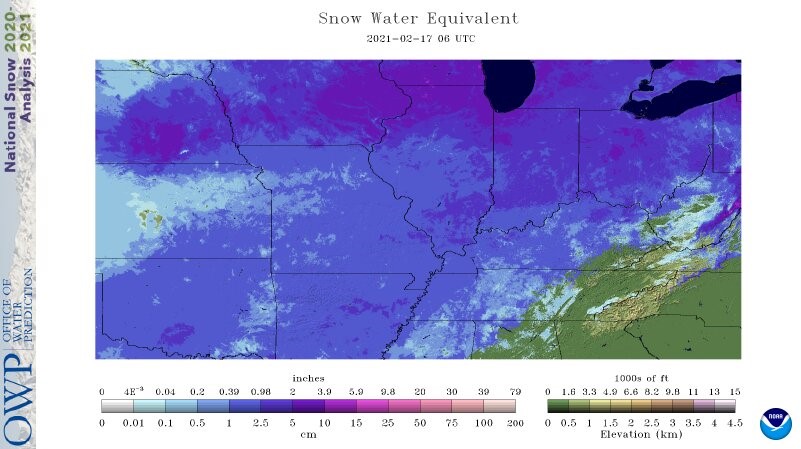
The most recent seasonal outlooks from the Climate Prediction Center for climatological spring (March – May) lean on a combination of long-term trends and ongoing La Niña conditions. The maps show elevated chances of a warmer and wetter than normal spring across the state.
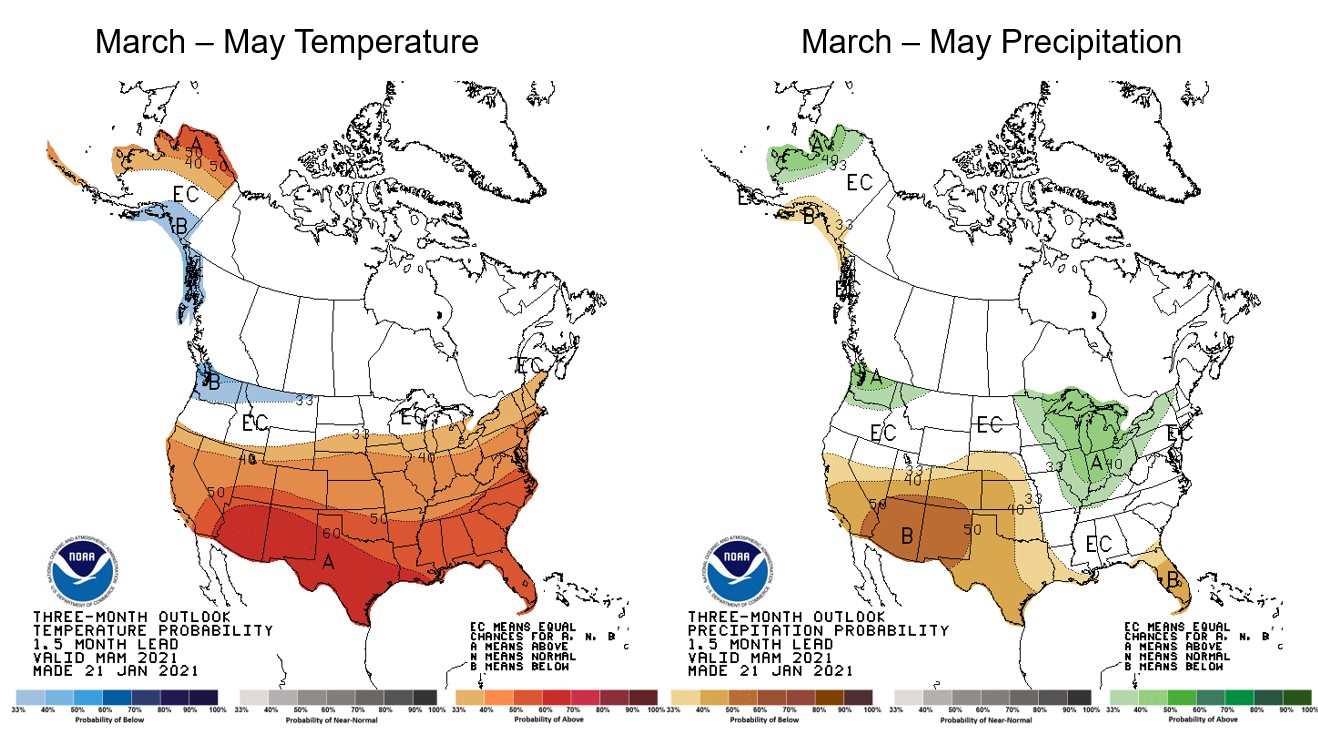
Trent Ford, Illinois State Climatologist (217-244-1330; twford@illinois.edu)
Demonstration of Production Methods for Ginger (Zingiber officinale) in Illinois
For many local food growers, common Midwestern vegetables such as tomatoes and cucumbers are the mainstays of their market strategy. Perhaps your farm is known for having the best tasting or earliest tomatoes. And if that’s what you are good at, then that tomato should be at the core of your business plan. After all, you can only sell what people will buy. This reasoning is what typically makes growing unique crops difficult. You may be able to grow a superb culinary ingredient, but if nobody recognizes it as food, it will not sell.
Yet, continual cropping of tomatoes in a high tunnel year after year does hold the potential for disease development. Is there a crop that gives as much return as a tomato that you could also use in your crop rotation plan to help break disease cycles? There is a trending crop that is showing more demand for local production and high sales – ginger, Zingiber officinale.
In 2020, Illinois Extension educator, Chris Enroth partnered with Western Illinois University horticulture professor, Dr. Shelby Henning to begin evaluating ginger’s performance growing in high tunnels in Illinois. To compare results additional partnerships included Spurgeon Veggies owner Eloise Spurgeon, a market and CSA grower in Galesburg, Illinois and Knox College farm manager Tina Hope also located in Galesburg.
Using an Illinois SARE mini-grant, the team was able to procure 70 pounds worth of ginger seed pieces split among the different sites, including a test plot at the McDonough County Extension office. In all four locations, the crop was regarded as successful, but there are certainly some things to learn when growing ginger. Following are those observations:
- It is possible when presprouting ginger to remove the new growth from the “seed” rhizome and plant these, similar to sweet potato slips. It was observed these ginger sprouts were stunted and produced weaker growth than those ginger sprouts that were left attached to the seed piece and planted together.
- Because ginger does not get planted in the high tunnel until mid to late May (due to late shipping of the seed piece and presprouting time), that may leave time for an early spring crop of greens or root vegetables that will be harvested prior to ginger planting. The hope is maximizing production in that row.
- Temperature management in high tunnels is important. We think of ginger as a tropical crop that prefers hot temperatures. However, it can get very hot in a high tunnel in Illinois during the summer. We found ginger that was provided afternoon shade or adequate venting performed better.
- Mulch is critical. Linked to the hot temperatures of the high tunnel, mulch is crucial to insulating the soil to reduce extreme fluctuations of soil temperature and moisture. Soil temperatures above 90 degrees Fahrenheit can lead to stress in this plant.
- Ginger not placed on a dedicated drip irrigation line did not perform well and we saw crop failure in unirrigated rows. Water stressed ginger would show leaf tip browning and yellowing. Increasing irrigation amounts reduced leaf browning and improved growth. (Note more irrigation means possibly more nutrient leaching.)
- Ginger does not compete well with weeds, notably grasses. This is another avenue where mulch can play an important role.
- Ginger does not tolerate soil compaction. A row of the WIU high tunnel had been compacted due to equipment use. That row performed the worst with a 30 percent increase of rhizome growth measured at the end of the season. Compared to the 85 percent growth in beds of well-drained soil.
- Fertility is important. Ginger rows placed on the same drip lines as tomatoes received the same fertilizer schedule. These seemed to perform well overall when compared to no fertilizer and soils amended solely with an early-season slow-release fertilizer. Ginger grown in-ground produces few feeder roots, making timely applications of fertilizer very important.
- No insect or rodent plant damage was observed. Even when adjacent crops were inundated with aphids, grasshoppers, or other pests.
- Processing the rhizomes for market was time-consuming. The rhizomes trap soil throughout the root cluster. Our farmer partners remarked that washing for display at the market took more time than they thought it would.
- Our farmer partners reported at the market and farm stand the ginger would sell out immediately. They used social media to promote that it would be available. Average price charged for ginger sold was $1.50 per ounce.
The team associated with this project will continue to grow and observe this potential Illinois crop. Future studies will examine different ginger varieties and growing systems that incorporate summer shade cloth or a removable caterpillar tunnel. It is our hope in the coming years to develop a crop profile for ginger that can be shared with Illinois growers interested in a crop that is steeped in culinary tradition and modern-day cuisine.
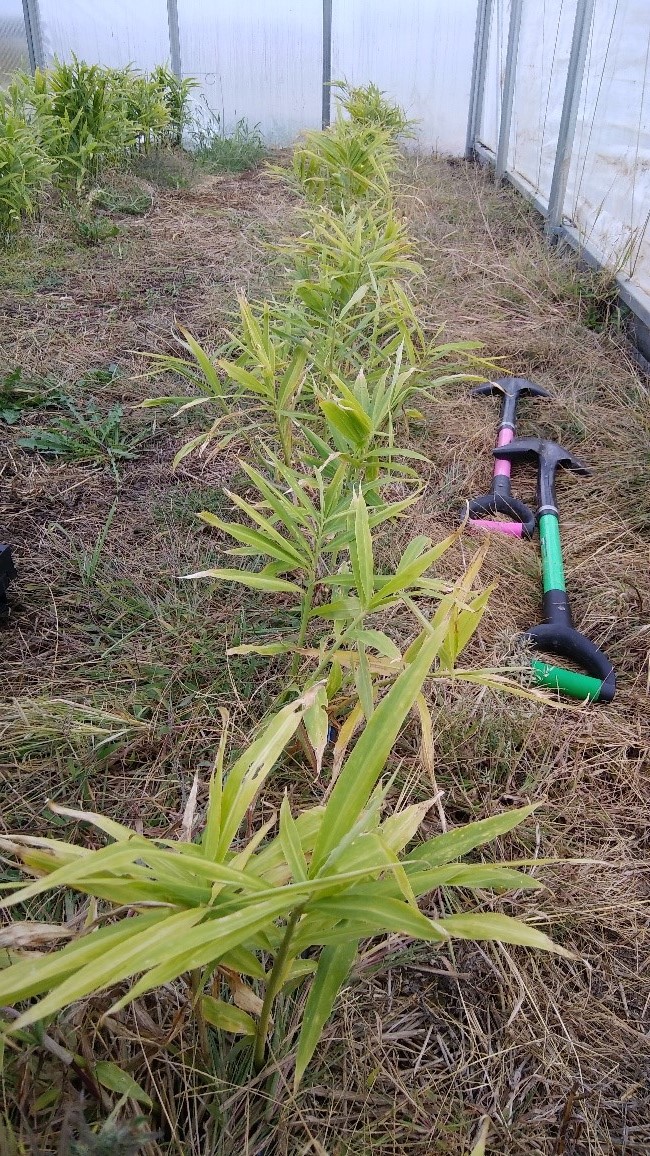
Ginger growing in compacted soils showing yellowing leaves and stunted growth. Photo by Chris Enroth.
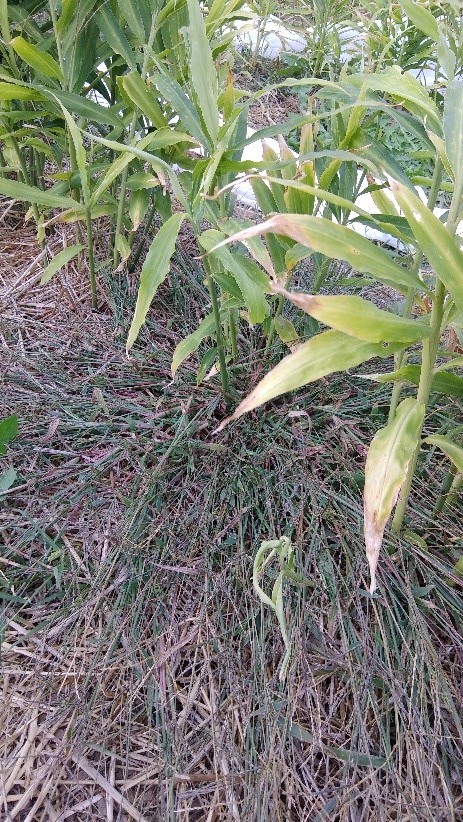
Competition from grasses reduces growth in unmulched rows. Being a monocot, ginger would be affected by many grass-specific herbicides. Photo by Chris Enroth.
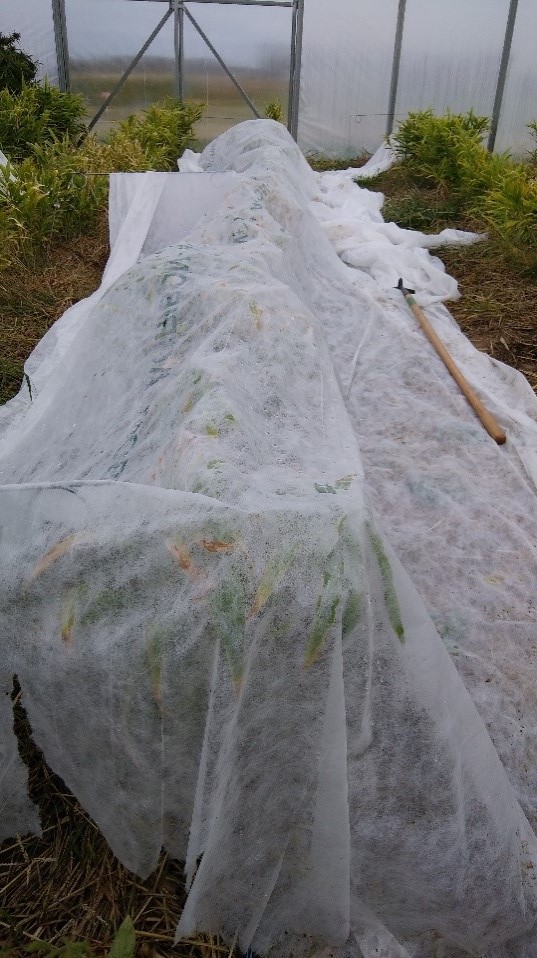
Fall harvest comparing the original seed piece (left) planted in the spring to the new growth harvested that same year in the fall (right). Photo by Chris Enroth.
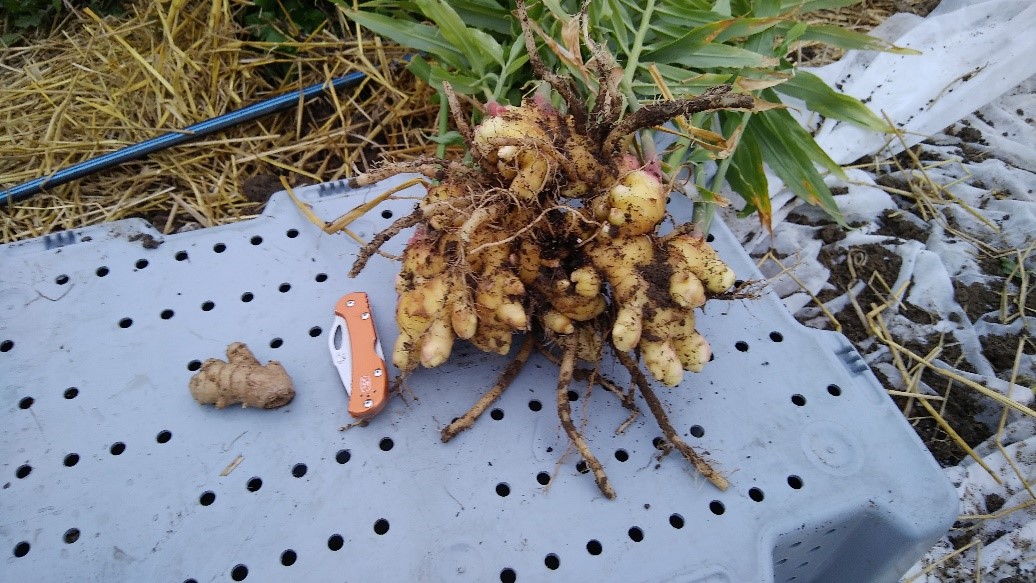
Fall harvest comparing the original seed piece (left) planted in the spring to the new growth harvested that same year in the fall (right). Photo by Chris Enroth.
Funding for this project was made through an Illinois SARE mini-grant.
Chris Enroth (309-837-3939; cenroth@illinois.edu)
Less Seriously
University of Illinois Extension Specialists in Fruit and Vegetable Production & Pest Management
Extension Educators – Local Food Systems and Small Farms |
||
Bronwyn Aly, Gallatin, Hamilton, Hardin, Pope, Saline, and White counties |
618-382-2662 |
|
Katie Bell, Franklin, Jackson, Perry, Randolph, & Williamson counties |
618-687-1727 |
|
Sarah Farley, Lake & McHenry counties |
847-223-8627 |
|
Nick Frillman, Woodford, Livingston, & McLean counties |
309-663-8306 |
|
Laurie George, Bond, Clinton, Jefferson, Marion, & Washington counties |
618-548-1446 |
|
Zachary Grant, Cook County | 708-679-6889 | |
Doug Gucker, DeWitt, Macon, and Piatt counties |
217-877-6042 |
|
Erin Harper, Champaign, Ford, Iroquois, and Vermillion counties |
217-333-7672 |
|
Grace Margherio, Jackie Joyner-Kersee Center, St. Clair County |
217-244-3547 |
|
Grant McCarty, Jo Daviess, Stephenson, and Winnebago counties |
815-235-4125 |
|
Katie Parker, Adams, Brown, Hancock, Pike and Schuyler counties |
217-223-8380 |
|
Kathryn Pereira, Cook County |
773-233-2900 |
|
James Theuri, Grundy, Kankakee, and Will counties |
815-933-8337 |
|
Extension Educators – Horticulture |
||
Chris Enroth, Henderson, Knox, McDonough, and Warren counties |
309-837-3939 |
|
Richard Hentschel, DuPage, Kane, and Kendall counties |
630-584-6166 |
|
Andrew Holsinger, Christian, Jersey, Macoupin, & Montgomery counties |
217-532-3941 |
|
Extension Educators - Commercial Agriculture |
||
Elizabeth Wahle, Fruit & Vegetable Production |
618-344-4230 |
|
Nathan Johanning, Madison, Monroe & St. Clair counties |
618-939-3434 |
|
Campus-based Extension Specialists |
||
Kacie Athey, Entomology |
217-244-9916 |
|
Mohammad Babadoost, Plant Pathology |
217-333-1523 |
|
